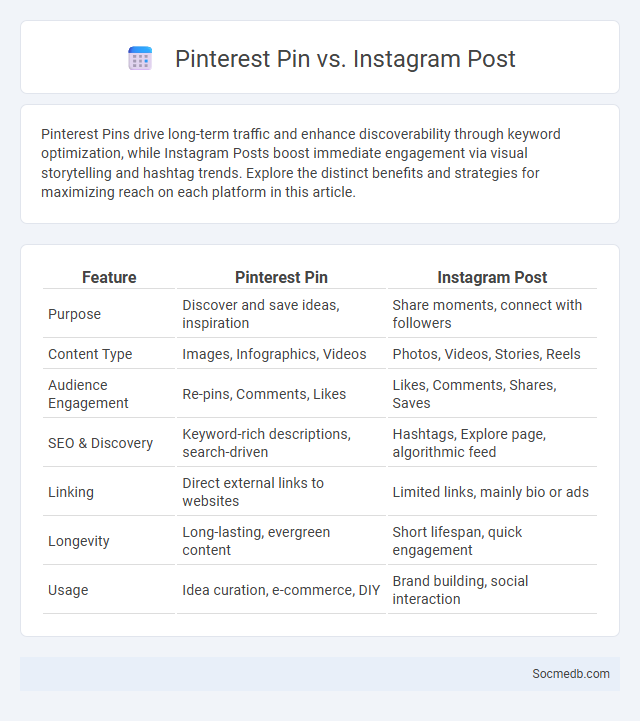
Photo illustration: Pinterest Pin vs Instagram Post
Pinterest Pins drive long-term traffic and enhance discoverability through keyword optimization, while Instagram Posts boost immediate engagement via visual storytelling and hashtag trends. Explore the distinct benefits and strategies for maximizing reach on each platform in this article.
Table of Comparison
| Feature | Pinterest Pin | Instagram Post |
|---|---|---|
| Purpose | Discover and save ideas, inspiration | Share moments, connect with followers |
| Content Type | Images, Infographics, Videos | Photos, Videos, Stories, Reels |
| Audience Engagement | Re-pins, Comments, Likes | Likes, Comments, Shares, Saves |
| SEO & Discovery | Keyword-rich descriptions, search-driven | Hashtags, Explore page, algorithmic feed |
| Linking | Direct external links to websites | Limited links, mainly bio or ads |
| Longevity | Long-lasting, evergreen content | Short lifespan, quick engagement |
| Usage | Idea curation, e-commerce, DIY | Brand building, social interaction |
Understanding Pinterest Pins: Purpose and Audience
Pinterest Pins serve as visual bookmarks that capture ideas, products, or inspirations tailored to specific interests and demographics. Their purpose centers on driving engagement through discovery and curation, appealing primarily to users seeking creative project ideas, shopping inspirations, or lifestyle content. Effective Pins leverage high-quality images, keyword-rich descriptions, and targeted hashtags to connect with niche audiences and enhance visibility within Pinterest's search algorithm.
Instagram Posts: Features and User Engagement
Instagram posts offer diverse features such as carousel images, videos, reels, and IGTV that enhance visual storytelling and user interaction. Interactive elements like polls, questions, and location tags increase user engagement by encouraging audience participation and boosting content visibility through the algorithm. Consistent posting schedules and high-quality visuals drive higher reach and follower growth, making Instagram a pivotal platform for brand promotion and community building.
What is Search Intent? Types and Importance
Search intent refers to the primary goal a user has when entering a query into a search engine, driving the relevance of social media content to meet user needs. The main types include informational, navigational, transactional, and commercial investigation, each guiding content strategy to enhance engagement and conversions. Understanding search intent is crucial for optimizing social media campaigns, improving targeting accuracy, and increasing organic reach by aligning posts with what users actively seek.
Visual Content: Pinterest Pin vs Instagram Post
Visual content on social media demands platform-specific optimization to maximize engagement, with Pinterest pins excelling due to their vertical format, high-resolution images, and keyword-rich descriptions that enhance discoverability through search algorithms. Instagram posts, designed primarily for square or horizontal display, emphasize aesthetic appeal and storytelling through curated visuals, captions, and hashtags that leverage real-time trends and community interaction. Your marketing strategy should tailor content to each platform's unique strengths to boost visibility, user interaction, and conversion rates effectively.
SEO Potential: Pinterest Pins vs Instagram Posts
Pinterest Pins offer superior SEO potential compared to Instagram posts due to their longevity and keyword-driven searchability on the platform. Your content on Pinterest can rank in both Pinterest's own search engine and general search engines like Google, increasing visibility over time. Optimizing Pins with relevant keywords and rich descriptions boosts discoverability, making Pinterest a strategic choice for long-term organic traffic growth.
User Behavior: How Audiences Navigate Each Platform
User behavior varies significantly across social media platforms, with audiences engaging differently based on platform design and content type. On Instagram, users primarily scroll through visual content and interact with Stories and Reels, while LinkedIn audiences seek professional insights and networking opportunities. Understanding how your audience navigates each platform optimizes content delivery and drives effective engagement strategies.
Algorithms and Reach: Pinterest, Instagram, and Search
Pinterest's algorithm prioritizes personalized content discovery, utilizing user behavior signals to enhance reach through curated visual search results. Instagram employs machine learning to rank posts based on engagement, recency, and user interactions, maximizing content visibility in feeds and Explore pages. Search functionalities on both platforms leverage keyword relevance and trending topics, optimizing content discoverability and expanding organic reach.
Content Strategy: Aligning Posts with Search Intent
A successful social media content strategy hinges on aligning posts with user search intent by targeting keywords and topics that resonate with audience needs. Creating informative, engaging, and solution-oriented content boosts visibility and drives higher engagement rates on platforms like Instagram, Facebook, and LinkedIn. Analyzing search behavior and trending queries ensures content relevance and enhances organic reach across social channels.
Conversion and Traffic: Which Platform Drives Results?
Facebook leads in driving conversion rates with its advanced targeting and diverse ad formats, delivering a higher ROI for e-commerce businesses. Instagram excels at generating high traffic through visual engagement and influencer partnerships, making it ideal for brand awareness and direct purchases. LinkedIn offers strong conversion potential for B2B marketing by targeting professionals with precise demographics and content-driven campaigns.
Selecting the Right Platform Based on Search Intent
Selecting the right social media platform depends heavily on your target audience's search intent, whether informational, navigational, or transactional. Platforms like Instagram excel in visual discovery and brand awareness, while LinkedIn caters to professional and B2B intent, driving higher-quality leads. Understanding your audience's intent helps you allocate resources efficiently, ensuring your content reaches users most likely to engage and convert.
 socmedb.com
socmedb.com